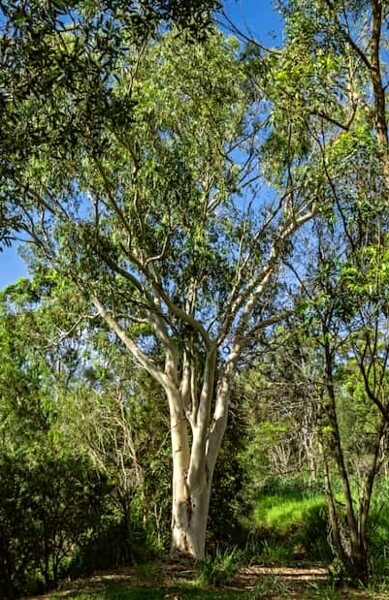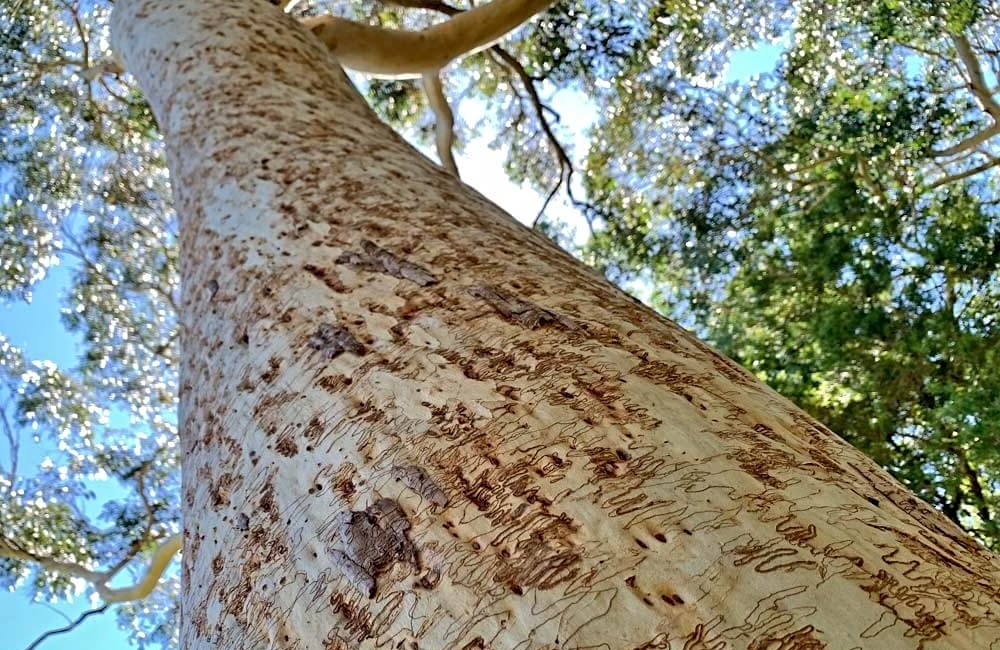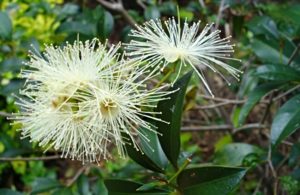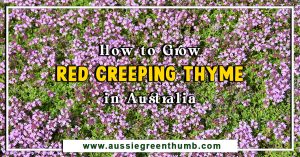Eucalyptus racemosa often gets mistaken for the better-known Eucalyptus haemastoma, because of their distinctive scribble pattern, which can often be found on the bark and is a truly serendipitous wonder of nature that will surely add interest to any native-focussed Australian gardens.
At 20m tall, it is a large tree, but not so large that it wouldn’t be at home in larger gardens, and it's really spectacular in parks thanks to the interest across its bark, and its generally twisted growth habit.
This article is packed with hints, tips and a few hard and fast rules for caring for, propagating and planting Eucalyptus racemosa.
More...

Source: Australian Native Plants
Family: | Myrtaceae |
|---|---|
Genus: | |
Species: | E. racemosa |
Common names: | Snappy Gum, Narrow-Leaved Scribbly Gum |
Origin: | Australia |
Location: | Outdoor |
Type: | Small - Medium Tree |
Growth: | avg. 20m tall |
Sun requirements: | Full sun |
Foliage colour: | Green |
Flower colour: | White |
Flowering: | Late winter - Spring |
Edible parts: | None |
Maintenance level: | Low |
Poisonous for pets: | Toxic to cats and dogs |
What is Eucalyptus racemosa?
Eucalyptus racemosa is a medium-sized tree with smooth mottled bark that often has very unique scribbly marks etched into the surface of the bark. Its better-known relative, Eucalyptus haemastoma, also wears these marks like natural graffiti, hence how they are often confused.
However, E. racemosa often has smaller fruit and narrower leaves. Its bark is smooth and mostly pale cream, white and grey, this makes a perfect canvas for its scribed markings.
Growing to around 20 metres tall, Eucalyptus racemosa can also be grown into a mallee in smaller gardens.
Growing the tree as a mallee allows you to limit both its height and spread, and is a wonderful way to grow any Eucalyptus with the distinctive lignotuber at its base – allowing multiple branches to grow to maturity, each with the more recognisably smooth bark, while the rough bark of the base is then restricted to ground level.
The process is similar to pollarding or coppicing but does not require repeat treatment. Due to their limited height compared to many towering eucalypts, they are often chosen as roadside or street trees. Living for at least 100 years they are a resilient and reliable Eucalyptus.
What is Snappy Gum’s Natural Habitat?
Eucalyptus racemosa grows happily on poor sandstone soil, in areas with high rainfall. For gardeners across Australia, that makes them ideal as these shallow rooted trees thrive in basic infertile soil, allowing for very low-maintenance gardening with quick results.
The scribble gum tree can be found growing peppered around locations in New South Wales and Queensland. It often grows naturally along coastland regions in the sun-tropical climates of eastern Australia, and tablelands or western slopes from Albury in New South Wales through to Gympie in South-Eastern Queensland.

Source: GardensOnline
Identifying Eucalyptus racemosa
Identifying Eucalyptus racemosa can be difficult, despite its distinctive patterning. This is because it is very similar in shape and form to two other species, which are also used as habitat for the moth that causes the scribbly patination of its bark.
The other two species are Eucalyptus haemastoma and Eucalyptus rossii.
Eucalyptus rossii grows to 20m but has a typically straight trunk. Its yellow bark is scribbled with insect patterns, and its leaves are 7-14cm long. The leaves are arranged alternately, and flowers form in clusters of between five and fifteen on unbranched pedicels.
The white flowers are followed by short woody spherical seed capsules, 3-6mm across.
Eucalyptus haemastoma grows naturally as a multi-stemmed tree from a short lignotuber. Its bark can be white or yellow depending on its age. In most ways, it is very similar to Eucalyptus racemosa, but has longer leaves (9-21cm) with larger white flowers, and large, valved, conical seed capsules, measuring 0.7-1.1cm wide.
Eucalyptus racemosa, in contrast, has shorter foliage, which is egg-shaped from young branches, and lance-shaped and curved on more mature growth, measuring 6.5-20cm.
The smaller, cup-shaped woody seed capsules are the easiest way to set it apart, but they can vary between conical, sup-shaped and hemispherical.
Common Uses for Eucalyptus racemosa
Almost all eucalyptus trees were harvested for their timber, which was found to be very useful for building work and construction, even canoe making. Today, Eucalyptus racemosa is rarely cultivated for timber or firewood on a commercial scale, but its wood is useful for a host of other manufacturing processes.
The resin is also found to be useful in tanning and dying natural fibres and also works as a natural preservative for them. The resin dries to a very hard amber-like form, meaning it can be stored, offering plenty of other uses.
Although there are no known edible uses for scribbly gum, as with most eucalyptus, resins and gums can be extracted from the bark and trunk which contain medicinal health benefits. As eucalyptus resins contain tannins, the astringent nature means the kino is useful for treating diarrhoea and intestinal inflammation.
Externally these kino resins are also used to treat skin ailments and sores along with the crushed-up leaves of E. racemosa, a remedy still widely used today.
How to Grow Eucalyptus racemosa
Growing Eucalyptus racemosa is really quite simple, but it is important to avoid boggy soils. Perhaps the most useful thing to know is that scribbly gum can be grown in most spaces.
If coppiced, it will fit in nearly any garden, and when grown from a sapling as a mallee, it is ideal for smaller gardens. But, in larger landscapes and parks, it can be left to grow into a tall, single-stemmed tree, with a wonderful profile.
Knowing how to grow it, and how to achieve that is the important thing though, so let’s dive into cultivation and propagation techniques for Eucalyptus racemosa.
Ideal Position for Growing Eucalyptus racemosa
If you are planning on coppicing Eucalyptus racemosa, it can be planted close to buildings, pathways, and wherever you like, but for taller trees, leave at least 15m between the tree and any buildings, whether it’s a standard or a mallee.
Once you’ve settled on that, follow the guides below for soil, light and shelter requirements for scribbly bark to get started.
Soil & Drainage
Similarly to most Eucalyptus, E. racemosa prefers moisture-retentive soil, as long as it is free draining. In its natural habitat, it grows on free-draining sandstone and will grow from seed in the shelter of its parent.
So avoid very boggy soils, or very loamy soils, and add plenty of sand or grit to clay or moisture-retentive soils to make sure young trees have the right balance while they establish. Nutrient levels are not particularly important as scribble gums can cope with draining loam, or poor sand.
One quite specific factor to consider when initially planting is that scribble gum prefers a soil pH of somewhere between 4.5-and 7.5, and alkaline soil can often lead to the yellowing of the leaves on young trees. It’s worth investing in a soil testing kit if you don’t have one already.
Light & Temperature
Full sun is ideal for Eucalyptus racemosa, especially in smaller gardens if they are grown as mallees. This prevents them from shooting upwards in search of light, which they will do if planted in the shade of a house, or in the shade of other trees.
Find a bright North-facing spot if you can. And for coppiced scribbly gums, aim for light shade to full sun.
Shelter
Most eucalyptus are shallow rooted so they like to be in a sheltered spot where harsh winds won’t affect the stability of the tree. This is important for mature trees as much as for younger trees, but they do cope with windy conditions once established.
Eucalyptus racemosa, although not the tallest eucalyptus, will grow one straight leader trunk unless coppiced or pruned into a mallee. This taller form can make them too top-heavy and prone to potential wind rock.
Planting Narrow-Leaved Scribbly Gum
Wherever you plant Eucalyptus racemosa, dig a hole that is a minimum of twice the width of the root ball. On heavy soils, add a layer of grit to the base of the hole to aid drainage.
Place the tree into the planting hole and position it with its best side forwards (all trees have a good side, don’t rush it), and then backfill the hole with soil. Firmly heel the root ball in, and water it in generously.
Finally, and essentially, stake the tree, with the stake driven in at a 45-degree angle toward the prevailing wind. Keep the tree stake in place for at least three years until there is no root rock.
How to Propagate Eucalyptus racemosa
Eucalyptus racemosa can be propagated from seed, cuttings and grafted cuttings, but seed is by far the simplest way to get started. Below, we’ve got instructions on growing scribbly bark from seed and how to graft.

Source: Australian Seed
Propagating Narrow-Leaved Scribbly Gum from Seeds
The best way to propagate Eucalyptus racemosa is from seed, sown on the surface of peat-free compost. A period of stratification can help to germinate the seed (a brief stay in the fridge will do the trick) but it isn’t absolutely essential for these Queensland natives.
Sow the seeds directly onto the surface of peat-free compost, and leave them somewhere warm to germinate. Keep the soil lightly moist until seedlings germinate, which usually takes about four weeks.
Once germinated, move them into the light, and continue watering. Once big enough to handle, potting on will be necessary but keep this to a minimum as all eucalyptus dislike root disturbance.
Propagating Eucalyptus racemosa from Grafted Cuttings
It is possible to grow scribbly gum from cuttings but grafting is more popular and more reliable. Eucalyptus racemosa, is simple to graft and can be done in a number of ways. The simplest is outlined below:
- Start with a well-rooted, 1-2 year-old Eucalyptus racemosa, grown from seed, or dug up from the garden.
- Remove the top growth of this plant, leaving about 15cm of stem at the base, cutting a V-shape into the cut point.
- Take semi-hard cuttings from a mature Eucalyptus racemosa, cutting an opposing V-shape at the node.
- Firmly insert the cutting into the groove in the root stock, making sure there is complete contact with the cut points.
- Secure them in place with tape, wax or tightly secured twine.
- Keep the rootstock compost moist until you see signs of new growth.
Caring for Eucalyptus racemosa
Mature Eucalyptus racemosa can tolerate temperatures down to -10°C, but younger plants will struggle with anything below 0°C. So for the first few years, if you are likely to experience winter frosts, it is important to thickly mulch the base of younger trees with a layer of wood chip or leaf mould.
Don’t let the mulch touch the stem (leave a ring of about 10cm around the base of the tree).
Once established, and properly rooted in place, with a few layers of bark to protect it from harsh winters, it will survive Australian winters easily. And then it’s all about pruning.
Pruning Eucalyptus racemosa
Pruning of your Eucalyptus racemosa should be done in late winter to early spring. These trees don’t go completely dormant, but at this time they can be pruned to encourage new growth, making them easier to shape and control.
Generally, eucalyptus trees don’t need pruning unless you are annually checking and removing any dead, damaged or diseased branches, but because this species makes such an effective mallee or coppiced tree, regular pruning is advised.
When grown in smaller to mid-sized species, coppicing is used to control and restrict the growth. This can produce a multi-stemmed tree but is most commonly used to create screening. However, with E. racemosa, this will reduce the possibility of seeing the unique scribbled forms on the bark.
Instead, you can cut overgrown trees right back into the lignotuber to encourage them to regrow as a multi-stemmed specimen. This form is called a mallee - a useful trick for any mid-sized eucalyptus tree if you want to keep it restricted in a smaller garden. This hard prune only needs to happen once.
Note: Most eucalyptus, E. racemosa included, have lignotubers so can regrow even after the harshest of annual prunes. Even if you went to the extent of burning your eucalyptus to the ground it could regrow, they can survive and thrive after widespread bushfires.
Common Eucalyptus racemosa Pests and Diseases
There are some common pests that negatively affect Eucalyptus racemosa, like eucalyptus beetles, which defoliate young trees, or gum moths that feed on the foliage voraciously.
Gall wasps can spread fungal problems, as well as weakening fresh foliage, and psyllids are a common issue for young trees, as well as spreading fungal infections between trees.
However, they are easy to manage, simply by removing damaged growth on young trees, and should be tolerated on mature trees and mature coppices, because their damage will rarely do lasting harm, and the foliage and flowers are an essential food source for wildlife. Spraying with any insecticide is damaging to that ecosystem.
Scribbly Gum Moth
One ‘pest’ species we need to talk about though, is the scribbly gum moth, Ogmograptis scribula (syn. Ogmograptis racemosa). Without this moth, these trees would be a whole lot duller, and they would never have got their incredibly appropriate name.
Although technically a pest, without this intruder, the Eucalyptus racemosa would not have been given its USP and common name scribble gum. The scribbly gum moth larvae are the culprit that causes the ‘damage’ to the trunk.
The scribbly gum moth lays its eggs in between the new and old layers of bark. The larvae bore into the new bark and form tunnels from feeding through the bark. The lines widen as the larvae grow and the old bark falls off to reveal the artists' work. This process has little to no impact on the tree's overall health.
Eucalyptus racemosa Frequently Asked Questions

Source: Northern Beaches Herbarium
What is the difference between Eucalyptus racemosa and Eucalyptus haemastoma?
Eucalyptus racemosa and Eucalyptus haemastoma both have uniformly smooth bark and are both affected by the scribbly gum moth, which is responsible for the unique scribble pattern that gives them their name (scribbly gums).
The difference between the two is in their fruit. E. haemastoma has larger fruits up to 1cm wide, distinct from the small 3-6mm wide fruits of racemosa.
What is Eucalyptus racemosa subsp. rossii?
Eucalyptus rossii is a distinct species but is often referred to by the synonym Eucalyptus racemosa subsp. rossii. The tree grows to a height of 20m with a 9m wide crown, The leaves, bark and overall habit of the tree are similar to E. racemosa, but this inland species have shorter seed capsules and matte leaves.
Is Eucalyptus racemosa invasive?
Eucalyptus racemosa is not reported as an invasive species, and is therefore considered safe to plant across most of Australia. At 20m tall it is one of the mid-height species, and will not outcompete most eucalypts for light if it does self-seed.
Worth noting is that there are some countries, notably Portugal, that do consider E. racemosa to be invasive and harmful to local ecologies.
Is Eucalyptus racemosa toxic to pets?
Eucalyptus racemosa, like all eucalyptus trees, is toxic to pets. Essential oils, oil diffusers, cut breaches, or dried leaves are all potentially deadly, so if your pet dog or cat consumes any part of Eucalyptus racemosa they should be taken to the vet as soon as possible.
Does Eucalyptus racemosa have invasive roots?
The roots of Eucalyptus racemosa are shallow and wide-spreading but rarely invasive or damaging to property. It is still worth planting them at a good distance away from houses or buildings though, as, like any tree, its strongest roots are within the shade of its canopy.
What trees are affected by the scribbly gum moth?
Ogmograptis scribula (syn. Ogmograptis racemosa), better known as the scribbly gum moth, lays its eggs between the new bark and the bark of the previous year’s growth, leaving wonderfully patterned burrows.
It affects several species of Eucalyptus, including E. racemosa, E. rossii, and E. haemastoma.
What is the lifespan of Eucalyptus racemosa?
Eucalyptus racemosa typically lives for well over 100 years and has a lignotuber, which allows it to regenerate after fire damage or heavy coppicing. They are long-lived trees and well worth the investment for the long-term benefit of the landscape.
What is the most common use of Eucalyptus racemosa?
The yellow fibres and resin are both used to tan and dye materials, and the timber is used as regenerative hardwood for structural and decorative work. Medicinally, the tannins of E. racemosa can be extracted to create a treatment for bladder inflammation and diarrhoea.
Why is Eucalyptus racemosa called snappy gum?
Snappy gum, the common name shared across several Eucalyptus species, including E. racemosa, refers to the ability of dead branches to snap clean across the grain, making it incredibly useful firewood, as it breaks down easily without needing to saw smaller branches.
Is Eucalyptus racemosa useful for wildlife?
Eucalyptus racemosa is useful to wildlife, but not outstandingly so. Its nectar-rich flowers form from July to September, which makes it a useful late-winter source of sugar for pollinators, birds and small mammals, but only for a very short flowering period compared to other eucalyptus trees.
Enjoy the Graceful Branches and Aromatic Foliage of Eucalyptus racemosa
Eucalyptus racemosa is a living work of art. The way that scribbly gum demonstrates the fine balance of nature should be applauded and cherished. Being able to visually appreciate this delicate patterning of natural bark, caused solely by one single species of moth is a gift from nature to us as gardeners.
When it comes to what we consider to be ‘pests’ in our gardens, we are too quick to eradicate everything.
Stop, think, and consider planting these trees at home if you’ve got the space to accommodate them because even if you’d prefer a ‘pest’ free garden, these bugs are beautiful, and a great source of food for something else down the food chain.
Grow your own Eucalyptus racemosa, even if it’s just for the moths.
Published on February 25, 2024 by Nathan Schwartz
Last Updated on March 25, 2024




